Quatro-Decadal Review: Asimov’s Science Fiction, November 1989, edited by Gardner Dozois
An unappealing cover by Wayne Barlowe, more on that in a second
After the somewhat uninspiring November 1989 Analog, I turned next to Asimov’s, and found it to be pretty good.
Editorial — “Half Done” by Isaac Asimov
Starting with the quote ‘Half done is hardly begun,’ Isaac Asimov (That’s Dr. Asimov, if you’re nasty) jumps into looking at how we conceptualize and compare time. Starting with the fact the Earth is 15 billion years old, half of that is 7.5 billion years, before our solar system existed by easily 3 billion years. Earth itself comes into play 4.6 billion years ago., and half of that, 2.3 billion Earth life is just prokaryotes. At 1.4 eukaryotic cells start showing up. Half of that, 700 million years ago, the highest life is just worms, nothing that even has shells.
The exercise is to show how rapidly things start to change. Leading to the question of how long can it go on? How do we get off on setting stories in the future. On thinking we can even realistically do it?
While reading this essay I could not shake the knowledge that Asimov had four years of life left.
Column, Letters
I get a kick out of the Letters Column, and this one is a mixed bag! Culture war issues rear their ugly heads, with Henry F. Smith of Miami saying:
The years when [Asimov’s] was being used to advance the cause of women’s liberation were particularly trying for me.
Dr. Asimov pushes back!
Can it be a bit of over-sensitivity on your part? Of course, all of us here are for freedom, decency, sweetness, and niceness and women’s liberation may come under those headings.
Then Jim Tomlison joins his voice to Norman Spinrad’s previous special book review of graphic novels.
I hope Mr. Spinrad’s article will help to open up a few skeptical eyes so they can see the vast wealth of excellent stories and artwork being published today as comic books. […] the comic industry is as rife with talent today as science fiction was in the Sixties. I long for the day when comic pioneers such as Alan Moore, Frank Miller, Mike Baron, Art Spiegelman, et al,., are ranked with the greats of the science-fiction field.
Oh how I hope Mr. Tomlison has lived to the modern day! Heck, I hope he made it to 1989’s Batman film. With movies made from Moore and Miller’s work, and Art Spiegelman being pulled from Tennessee middle-school curriculums, and the tsunami of super-hero movies and streaming shows. Does he find himself in a paradise, or is it more of a cautionary tale worthy of Rod Serling?
Letters roam about a wide range of subjects, although three writers bring up stories that ‘offend’ them.
Ironically, the last letter writer (Gili Bar-Hillel (age 14)) notes that it was “Flowers for Algernon” and “All Summer in a Day,” which he read in school, were what hooked him on sci-fi.
I’m going to pause this review here and climb up on my high horse for a second.
I’ve met many people who have said that all the ‘great’ science fiction they were forced to read by The Man back in middle school completely turned them off of science-fiction, citing “Flowers for Algernon” and “All Summer in a Day” specifically. These are super-depressing stories; not that they are bad stories, but they are so sad and grim. Is that still going on? Are we still forcing these two stories on middle-schoolers, or was that just a 70s-80s thing? Bueller? Bueller?
Off the horse and into the magazine!
Column — Neat Stuff by Matthew J. Costello
Costello goes into an odd ramble-y introduction, finally focusing in on Jane Yolen saying the next frontier in fantasy would be non-Celtic, and non-Nordic. Costello immediately brings up “The Ring of the Nibelungen” saga. And he goes in deep. The whole thing seemed like a painful misfire, with Yolen trying to move the needle away from white-dudes and northern Europe, he doubles-down on the white-dudes from northern Europe.
Art by A.C. Farley
Fiction: “A Touch of Lavender” by Megan Lindholm
The cover story, and the odd unappealing creature is explained: A Skoag, an alien race that is starting to move to earth—where The Man welcomes them somewhat gingerly in the hope that they will share some of their powerful technology, which they seem unwilling to do, or even to understand that such a trade may be in order.
There is a lot of set-up to this story, the Skoags are mostly outcasts from their own world; they can imitate any sound through bladders under their skin; their skin also secretes a neurotoxin that will give you powerful and addictive dreams, but it’ll make you deaf and you’ll descend into Skoag-stroking junkiedom.
Lindholm really does have her aliens roaming around their Skoag-ghettos wearing transparent plastic suits, just as Farley represents on the cover.
The aliens have been around for years by the time 7-year old Billy comes onto the scene. Billy knows enough to recognize some recently arrived aliens in Seattle.
But there were no gropies around these Skoags, and because they all still had crests, I knew they were new to Earth. […] One of these Skoags had the tallest crest I’d ever seen, like a king’s crown, and purple like a deep old bruise.
This Skoag develops a keen interest in Billy’s mother — a woman who has spent her adult life finding, falling for, and being left behind by a bunch of sad-sack musicians. The Skoag, which they nickname ‘Lavender’ because of his crest, hangs around them quite a bit, and his presence eventually leads to her accidentally getting addicted to the skin-secretion neurotoxin, forcing Lavender to serve, in a strange horrid way, as a bit of a father-figure or at least a friend, to Billy. His mother has a baby, which Billy assumes is just from his mother fooling around with yet another struggling musician.
Lavender cares for them all in his own strange way, but there is the mother’s addiction to the skin-slime. And, in spite of what I shouted down from my high horse, this story just would not work if it were not for Lindholm’s unblinking depiction of crippling poverty and addiction. Billy’s mother goes through all the stages, Billy and his sister get taken away by The Man, and eventually manage to get back.
Art by A.C. Farley
All the other Skoags play/sing copies of human music, but Lavender makes up his own, meaning he must be some kind of priest-level Skoag, or at least had been once. Forces within the Skoag homeworld ensure Lavender comes to a bad end, but by then Billy has his hopelessly addicted mother and his newborn sister to take care of. He has to stay with his mother because if The Man picks them up, they’ll take his sister and that’s not what he promised Lavender or himself. So, he’s got to keep the aid checks coming, and that means he has to have his mother at least functional enough to get along with Child Protective Services, and there is only one lever that you can use with a junkie.
And since Billy isn’t the only one to make promises he leans, leans hard, on one of Lavender’s lone Skoag allies to get his mother her fix.
After that first harrowing encounter,
“Remember,” I said as he waddled up the ramp. “Next Wednesday. It’s important. And you promised Lavender.”
[…] the fat Skoag paused on the ramp.
“For Lavender,” he said, like brass trumpets coming from a far hill. “Only for him would I do this thing. Only for him.”
I knew then that the fat Skoag was close to hating me tonight, and that it didn’t have to have been that way. […] I watched the fat Skoag leave and felt impish and sly and small for trading on his loyalty to Lavender. But I had to, to keep Lisa safe. Sometimes the only thing I was sure of was that Lavender had entrusted Lisa to me.
Eventually Billy discovers that Lisa is something special to the Skoags, special enough that, once they finally see her, they crowd the street making an incredible din. A very large and important Skoag, with guards provided by The Man, shows up and Lisa happily runs to him and The Man hustles them away. Some time later some Skoag technology starts to trickle in.
And Billy? Outside of the incredible din breaking his mother Skoag-slime addiction, Billy gets jack/squat but the knowledge he did his best with what he had.
It is a story that, once you get invested in it, it is well worth it. But it is a hard story, like “All Summer in a day.” Twenty Year-Old Me (20YOM) would have probably been on the fence about this tale, probably not disliking it, but not really liking it all that much. The story was nominated for a Hugo award.
Megan Lindholm may be more familiar to you under her other name of Robin Hobb. She has had quite a career and won a World Fantasy Lifetime Achievement Award in 2021. She has website at www.meganlindholm.com/index.htm.
Art by Bob Walters
Fiction: “Ride to Live, Live to Ride” by Allen M. Steel
Main Character Virgin Bruce, an ex-biker on the run from his old gang, the Satan’s Exiles, works in space. It is a swingin’-dick space-miner story, with Bruce getting crosswise with Henry Wallace, the asshole in command — who is not to be confused with Hank Luton, the construction supervisor.
Virgin is a wildcard who plays by his own rules and manages to cut his work pod in front of a freighter from Earth. Henry Wallace, asshole in command, is mad as hell and going to can his ass once he gets back to Vulcan station.
Actually, it wasn’t the thought of getting fired and shipped back to Erath that bothered him so much. He was sick to death of space; he wasn’t particularly stuck on beamjack work, and sometimes he thought he would gag if had to swallow any more of the freeze-dried quango they served in the mess deck. He wanted to go back, but the time wasn’t right yet. The heat hadn’t blown over down there yet. If he went back now, it would be only a matter of time before the Satan’s Exiles found out where he was and tracked him down.
He’s getting ready to swallow his pride, pucker up and kiss ass and then eat a shit sandwich to keep his job when a major accident happens at Vulcan Station. One of the other work pod’s has a catastrophic explosion related to a off-spec fuel cell. Worse yet, one of the “Hot Dogs,” the pressurized personnel modules made of mylar is damaged in the explosion.
A quick scene shift to the inside of one of the hot dogs: zero gravity, routine stuff going on, then a struggle for life and limb with people half-suited up and rushing into the metal sleeve between the rapidly decompressing hot dogs where they are trapped.
Virgin Bruce has a seal kit in his pod which could help the situation at the hotdogs. Two guys are in the hot dog, one salty old hand, one panicked newbie. The old hand is half in a spacesuit and gets the idea to stick his gloved hand through the hole in the mylar.
Virgin Bruce, on the outside, sees the glove sticking out and applies sealant and saves the day (well, except for the people who were killed instantly) and command asshole Henry lets him keep his job.
This story was good, but also confusing, with its large cast of characters and a lot of jargon (Olympus station, Vulcan Station, the construction shack, power sats) I was never 100% sure what they were doing. I got the feeling like maybe there were other stories in Virgin Bruce’s life that the reader was supposed to know about. I did find it interesting that there was a certain realism to the story, where Bruce isn’t THE hero, so much as one of many people who do their part in the emergency — something that Fifty Year Old Me (50YOM) totally understands. 20YOM might have found the whole thing a bit tiresome.
Art by Anthony Bari
Fiction: “Chiprunner” by Robert Silverberg
In 1988 ‘Cyberpunk’ is still a way off from popular terminology, and Silverberg’s story is kind of what you’d expect of a guy who knows it exists but doesn’t know the ins and outs.
15-year old Timothy is starving himself to death because he wants to disappear. He has this odd belief that he can sink down into the microchips in his computer, where he will be able to run down the corridors of the chips with the very electrons.
The narrator, a psychologist treats it like an odd case of anorexia, but Timothy claims he runs into a barrier, deep down, keeping him from where he wants to go. He believes that if he can lose the weight (all of it), he’ll be free.
Silverberg has to dig pretty deep to keep this one going. There is a lot of ink spilled on the Los Angeles culture of the near future, with everybody knowing everybody else because they cheated on their ex wife with them, and he’s set up the psychiatrist with nightmares of shrinking. For all that, Timothy just up and dies at the end. The psychiatrist assumes, or maybe hopes, or maybe forces himself to believe, that some part of Timothy is down among the electrons and the angstrom units.
Art by Hank Jankus
Fiction: “Dog Walker” by Orson Scott Card
A second groping attempt at cyberpunk. The Crystal Kid, who took a bullet to the head at nine but in this near-future world his head was packed with supergoo and light pipe — keeps him alive, and conscious, but it has some side effects. One side effect is that he stops growing (now being a 21 year-old in a 9 year-old’s body) and also he develops an affinity for figuring out people’s computer passwords.
Give me five minutes with anybody’s curriculum vitae, which is to say their autopsychoscopy, and nine times out of ten I’ll spit out their password and get you into their most nasty sticky sweet secret files.
The Crystal Kid is hired to do a job by Dogwalker, he’s got an inside man at Federal Coding and Dogwalker wants to get into the system and get 10 green cards — unlimited international travel (yes, like Casablanca).
Dogwalker is a kind of pimp moving “dogs” people even worse off than the Crystal Kid, to people who usually have rough sex with them.
Anyway, they have to get the mark’s fingerprints (using a hired girl who cries on his shoulder), and they work the Crystal Kid into a babysitting visit and get him into the house, where he gets in and noses around.
The plan is successful! At least, that part of the plan, the second part is to sell those greencards for millions to certain organized crime outfits. It all works swimmingly — or does it?
The greencards show up in a week, which is a couple of days too long. Their inside man has disappeared.
How? Their mark is so paranoid he always enters his password wrong on the first try and when it shows up in the computer logs as going through on the first try — that’s how he knows someone has been up to something.
Dogwalker and the Crystal Kid can’t turn themselves in, because their Inside Man already did.
Dogwalker is captured by the mob and they pump a bunch of goo into his head and the Crystal Kid has to own him and take care of him as a living warning to others. It is pretty grim because throughout the setup for heist Dogwalker has become the Crystal Kid’s only real friend.
It’s not a bad story, but not a great one. This is a weirdly bleak future that Card is presenting, made bleaker by focusing on those on (or beyond) the margins. The best part is that at the end it is revealed that the odd narration is the Crystal Kid’s last will and testament, ‘cause someday, somehow, he’s going to get those mobsters back. 20YOM would have gotten a kick out of this one.
Poem — Balanced Scaled, by Jack C. Haldeman II
Startled by an armadillo last night.
He was outside my tent flap,
All scales and nervous eyes.
He looked into my world,
I looked out to his.
I stayed where I was.
He moved on.
As a backpacker, I like this one. In fact, I lived this one, but it was a skunk, not an armadillo.
Fiction: “The Front Page” by Ronald Anthony Cross, art by Robert Shore
Tabloid reporter out running up stories, the rub is that all the weird tabloid stories are true. Vampires and aliens and such. …this is not nearly as funny as you would think…
Speaking of funny, here is an interesting thing. I’ve gone on in these retro reviews about how in the late 60s and 70s a ton of Big Laws were enacted re: Environmental Protection. As of August 7, 2022 the Inflation Reduction Act was signed into law, which among other things is the largest piece of climate change legislation enacted in the U.S.
Art by Laura Lakey
Fiction: “No Spot of Ground” by Walter Jon Williams
Okay, so first thing is first, I’ve met Walter Jon Williams at Texas sci-fi conventions. While we don’t really know each other, I have met him.
The issue finishes off with this alternate history story. The alternate part? Edgar Allen Poe didn’t die after a binge in Baltimore, meets a wealthy southern widow, marries her daughter, and sets himself up as a man of ease. A true southern gentleman at last!
But then the Civil War starts, and he joins up to fight for the South. The story catches up with him at the battle of Richmond, where he is a general. Poe is still very much Poe — smart, fiery, racist, and paranoid.
The story has a lot of plates spinning, the tale of what happened to Poe between Baltimore and signing up for the war, what he’s been up to during the war, what is going on with the war at the time of the story, and what happens real-time at the battle of Richmond. Williams does all of this quite well.
People who are into the history of the civil war will breeze through this story with ease, but that person is not me, and doubly not 20YOM. However, two factors are in my favor — factor 1, this is a really great story, and factor 2, 50YOM lives in an age of wonder, and I can google ‘brigade’ and ‘division’ and ‘battalion’ and the various generals to keep up with who is who and what is going on.
Allow me to spin some of the plates:
After Baltimore:
In Mrs. Forster Poe could almost see Mrs. Clemm — but Mrs. Clemm idealized, perfected, somehow rarified, her poverty replaced by abundance, her sadness by energy, inspiration, and hope. How could he help but see Virginia in her sparkling daughter?
Art by Laura Lakey
Early war action, at the crushing defeat at Cemetery Ridge:
The first sound he heard, even over the tear of battle, was a voice saying “nevermore” Huginn and Munnir [the two ravens that are the mascots of his brigade] were croaking from the clover behind him, their standard-bearer having been killed by the same shell that had dropped Poe
A later battle where he reaps the punishment of being right at the wrong time:
But by then Poe was not with the army. Only a few days after taking command, Lee went on the offensive, and Poe, supported by exemplary reasoning and logic, refused point-blank Harvey Hill’s order to take his brigade into Boatswain Swamp.
That quote also serves as an excellent example of the kind of thing, if you are not a big civil war fan, you are going to have to use some Google-fu. It appears to be an oblique reference to a brigade that suffered 75% casualties at the actual battle of Gaines’ Mill.
Poe’s been in the army, out of the army, then back in and now finds himself closing in on Richmond and even there, he can’t shake the feeling he’s not really in the in-group, which is just as well ‘cause the in-group is full of fools. There is a lot of military jargon and historical references, and it appears that Lee’s army is up against a lot more Yankees than anybody (but Poe) suspects. At one point he realizes that his horses are calling out into the night to Yankee horses — which are not supposed to be there.
He listened as the horses called to one another like bugles before a battle, and he thought: The Yankees are moving, and they’re moving along my front.
Art by Laura Lakey
Poe is correct that the battle is not going to go well, and events prove him right — it is a defeat to the South, but even then, he knows that it isn’t a crushing defeat, not a decisive defeat. He knows that the war is going to go on, grinding the South down.
While “Lavender” and “Dog Walker” rely on the relationships between the characters for their power, “No Spot of Ground” often relies on Poe’s relationship with himself and the rapidly changing world around him. And he hates how the world is changing.
“Whitman is the perfect Yankee poet,” Poe said. He drove his stick into the soil as if the earth hid Walter Whitman’s heart. “No sublimity, no beauty, just stacks of prose disguised as poetry — sometimes not even prose, only lists. Lists of ordinary things. Produced so many stanzas an hour, like yards of cloth in a shoddyworks.” He drove the stick again. “Like Yankee soldiers Not inspired, just numerous.”
A grimly satisfying story to end the issue.
Previous entries the Quatro-Decadal Reviews include:
November 1969
Amazing Stories
Galaxy Science Fiction,
The Magazine of Fantasy & Science Fiction
Worlds of If
Analog Science Fiction/Science Fact
Venture Science Fiction
A Decadal Review of Science Fiction from November 1969: Wrap-up
November 1979
Quatro-Decadal Review, November 1979: A Brief Look Back
The Magazine of Fantasy & Science Fiction
Galileo Magazine of Science & Fiction
Analog Science Fiction Science Fact
Isaac Asimov’s Science Fiction
Amazing Stories
Omni
A Decadal Review of Science Fiction from 1979: Wrap-up
November 1989
Jump Back! Quatro-Decadal Review, Looking Ahead to November, 1989
Amazing Stories
Analog
Adrian Simmons is an editor for Heroic Fantasy Quarterly, check out their Best-of Volume 3 Anthology, or support them on Patreon!
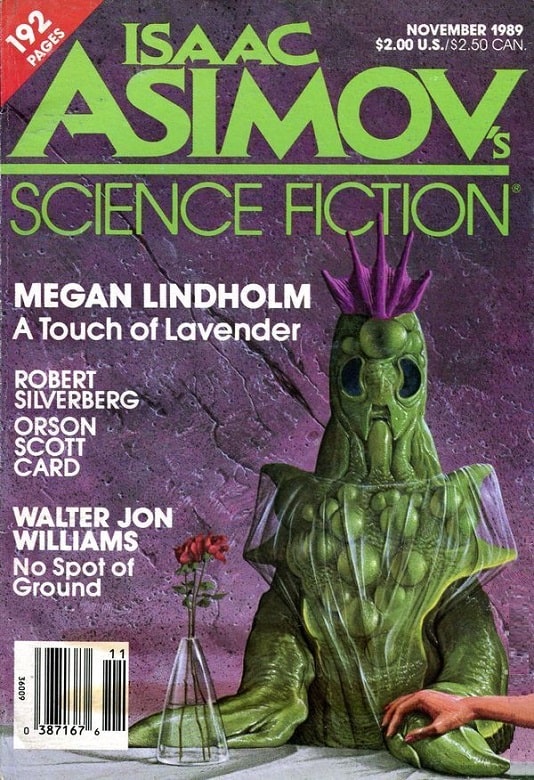
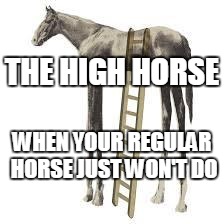

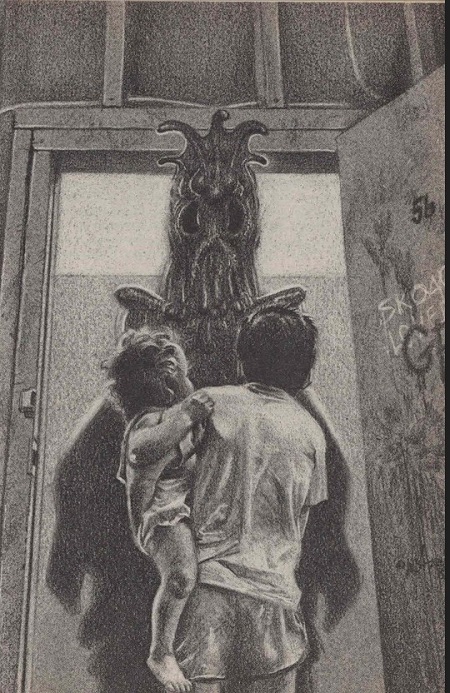
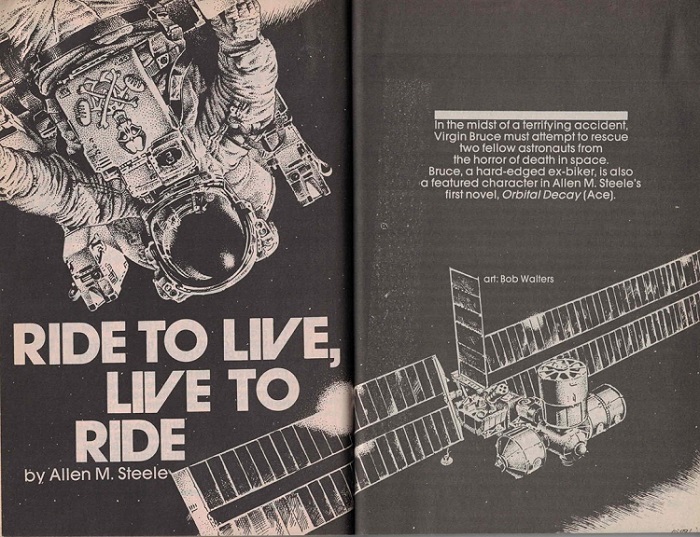
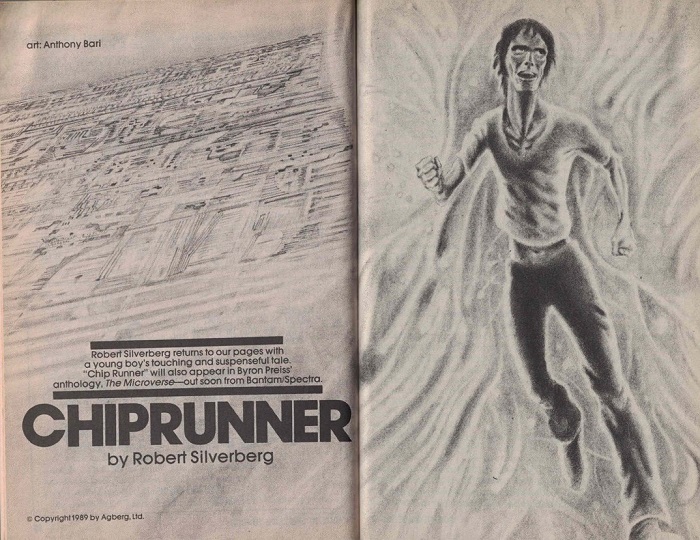
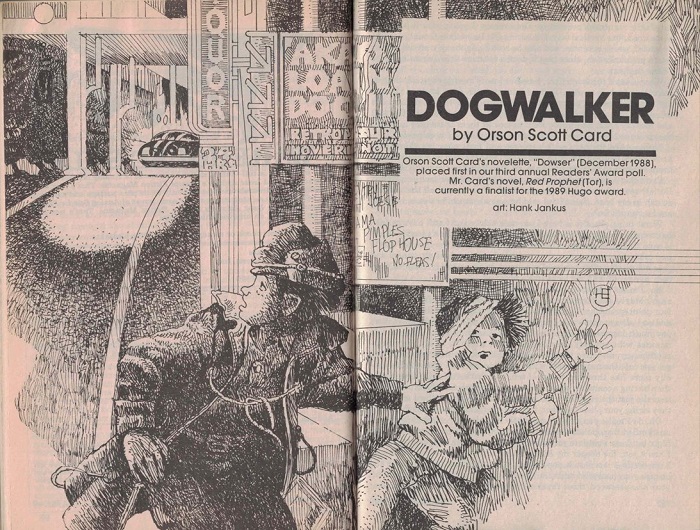

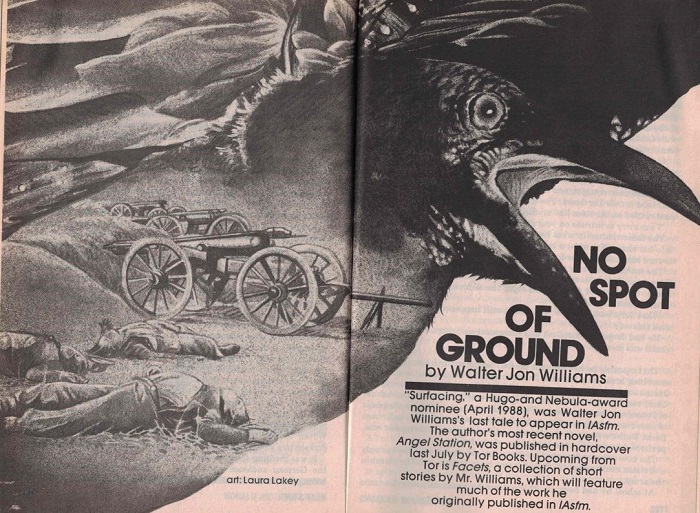

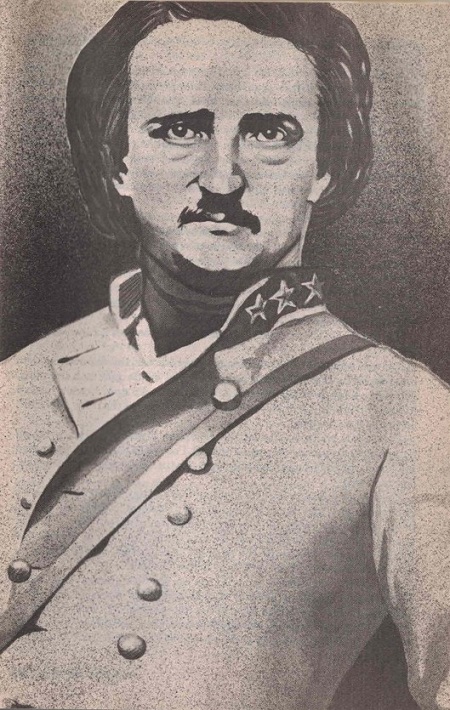
My only solid recollection of this issue of Asimov’s is Walter Jon Williams’s alt-history of Poe in the Civil War. Being a bit of a military history buff, it would have then (and now) stuck with me pretty readily. And the slighting appraisal of Whitman is a very apt encapsulation of the Southern attitude toward the North: big, bulky, machine-made, therefore soulless, unlike our “true” Cavaliers. The Lost Cause myth in miniature.
Also, another memorable feature is the artwork for the story, though the illustrator is Laura B. Lakey (final ‘y’), who is married to artist/writer John Lakey and with him is part of the Artifact! art studio, along with her sister-in-law, Val Lakey Lindahn, one of my very favorite Asimov’s artists.
Thank you, Mr. Simmons, for resurrecting these memories.
I can see how William’s story would stick with a person– it has certainly stuck with me. And yes, Poe trying to encapsulate his hatred of the north through his hatred of Witman (and simultaneously critiquing the literary scene of the day) is one more skillfully done parts of the story. William’s does a great job at making you simultaneously sympathetic to Poe, but also feeling bad for being sympathetic to him!
I corrected Lakey’s name, too– thanks for pointing that out!
I never read “All Summer in a Day” until a few years ago, and it absolutely knocked me out. But then my favorite Bradbury when I was a kid was “Pillar of Fire” – talk about a downer!
Well, “All Summer in A Day” might be a better book to read as an adult than a child. And to be clear, the occasional downer story is good for a kid, but (to my recollection), all the sci-fi we read back in the day was bleak. Bleak, I say! It seemed to be such a jarring thing when almost all the sci-fi you saw on TV was much more positive.
I’ve never even heard of “Pillar of Fire”, but I may dig it up on youtube.
I remember lying on my sofa and reading this issue during my first semester in graduate school. I’m not sure I read the whole thing, but I know I liked the cover story.
The cover story is quite good. I assume that if you’d read “No Spot of Ground” you’d remember it.
I still have the hardcopy and could send it to you if you want to see how your take matches mine!
I still have my copy, too. Thanks for the offer, though.
Walter Jon Williams
Allen Steele
Megan Lindholm
Orson Scott Card
Robert Silverberg
A crazy good issue, as three of my favourite authors from the 80s are in one magazine!
Indeed it was! Those authors managed to put Asimov’s over the top in the final tally of the November ’89 magazines.
https://www.blackgate.com/2022/08/29/quatro-decadal-review-emasimovs-science-fiction-november-1989em/#comments